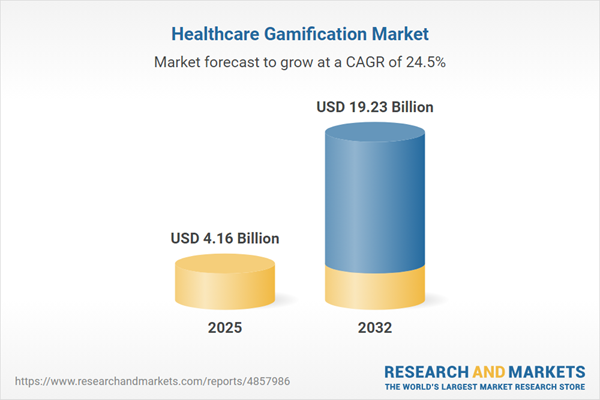Speak directly to the analyst to clarify any post sales queries you may have.
Healthcare gamification is rapidly reshaping patient engagement strategies, offering senior decision-makers tangible solutions to drive enhanced outcomes, treatment adherence, and digital health innovation. The Healthcare Gamification Market is demonstrating significant momentum, reflecting its increasing role in healthcare transformation across global regions.
Market Snapshot: Healthcare Gamification Market Growth
The Healthcare Gamification Market grew from USD 3.33 billion in 2024 to USD 4.16 billion in 2025. It is expected to continue growing at a CAGR of 24.48%, reaching USD 19.23 billion by 2032. This expansion confirms robust demand for platforms integrating interactive game elements—such as challenges and rewards—within patient engagement and clinical adherence programs. As digital health adoption accelerates, gamification remains central to motivating and empowering patients while supporting value-based care initiatives.
Scope & Segmentation
This report dives into the evolving ecosystem of healthcare gamification, mapping opportunities across platforms, application areas, user groups, and global regions. Major segmentation areas include:
- Delivery Platform: Mobile devices (including smartphones and tablets), wearable devices (such as fitness bands and smartwatches), and web-based solutions for data visualization and administration.
- Application Type: Chronic disease management modules targeting asthma, blood glucose, and blood pressure adherence; fitness and wellness tools with exercise tracking, coaching, and nutrition monitoring; digital interventions addressing mental health via cognitive behavioral therapy and mood tracking; and rehabilitation modules offering progress tracking and virtual exercises.
- End User: Providers such as clinics and hospitals implementing gamified protocols for monitoring and patient pathway support, alongside patients engaging in self-management and lifestyle interventions.
- Regional Coverage: Americas; Europe, Middle East & Africa; and Asia-Pacific—addressing national healthcare systems, evolving regulatory frameworks, and digital readiness. Key countries and regions include the United States, Canada, Brazil, Germany, Saudi Arabia, China, India, Japan, among others.
- Leading Companies: Market analysis covers Akili Interactive Labs, Ayogo Health, Cardinal Health, CogniFit, Experion Technologies, Fitbit, Folio3 Software, higi SH, Hurix Systems, Koninklijke Philips, Mambo Solutions, Microsoft, Omnicare, Oracle, Rally Health, Strava, SupperBetter, Under Armour, Virgin Pulse, and WeFitter.
Key Takeaways for Decision-Makers
- Gamification is driving a shift from basic rewards to intelligent, adaptive experiences by leveraging machine learning and real-time personalization in healthcare platforms.
- Augmented and virtual reality elements are enhancing rehabilitation, transforming traditional exercises into immersive and motivating environments.
- Integrating gamified tools into electronic medical records and clinical workflows is aiding both providers and patients, reinforcing adherence and remote monitoring.
- Collaboration between technology developers, healthcare institutions, and data analytics firms is accelerating the development of validated, user-centric solutions.
- Regional diversity shapes adoption: while North American and Asia-Pacific markets demonstrate rapid scale through strong digital infrastructure, regions in Europe and Africa focus on interoperability and equitable access.
Tariff Impact: U.S. Measures and Industry Response
- New U.S. tariffs on components like sensors, circuit boards, and display modules have increased manufacturing costs for wearables and mobile devices in 2025.
- Manufacturers are adopting strategies such as supply chain diversification and domestic partnerships to control costs and maintain competitiveness.
- Procurement teams in health systems are adjusting by focusing on total cost of ownership, seeking volume-based agreements, and leveraging negotiating power amidst market shifts.
Healthcare Gamification Market: Methodology & Data Sources
This report relies on a rigorous combination of primary research—interviews with clinicians, technology leaders, and patient advocates—and secondary research, including peer-reviewed publications, regulatory analysis, and authoritative white papers. Data was validated through triangulation, surveys, and insights from expert panels to ensure reliability and depth.
Why This Report Matters for Senior Leaders
- Aligns gamification strategies with organizational objectives and regulatory requirements, supporting long-term clinical and operational excellence.
- Enables informed decision-making by mapping the competitive landscape, segment growth, and emerging regional trends across established and developing markets.
- Delivers actionable insights for investment prioritization, vendor selection, and deployment of scalable, interoperable solutions tailored to varied end users and regulatory contexts.
Conclusion
Healthcare gamification enables stakeholders to enhance patient engagement, improve clinical pathways, and foster innovation in care delivery. This report provides a comprehensive foundation for leaders seeking to translate market insights into effective digital health strategies and measurable outcomes.
Additional Product Information:
- Purchase of this report includes 1 year online access with quarterly updates.
- This report can be updated on request. Please contact our Customer Experience team using the Ask a Question widget on our website.
Table of Contents
3. Executive Summary
4. Market Overview
7. Cumulative Impact of Artificial Intelligence 2025
Companies Mentioned
The companies profiled in this Healthcare Gamification market report include:- Akili Interactive Labs, Inc.
- Ayogo Health, Inc.
- Cardinal Health, Inc.
- CogniFit Inc.
- Experion Technologies.
- Fitbit, Inc.
- Folio3 Software Inc.
- higi SH LLC
- Hurix Systems Pvt. Ltd.
- Koninklijke Philips N.V
- Mambo Solutions Ltd.
- Microsoft Corporation
- Omnicare
- Oracle Corporation
- Rally Health, Inc.
- Strava, Inc.
- SupperBetter, LLC
- Under Armour, Inc.
- Virgin Pulse
- WeFitter
Table Information
| Report Attribute | Details |
|---|---|
| No. of Pages | 183 |
| Published | November 2025 |
| Forecast Period | 2025 - 2032 |
| Estimated Market Value ( USD | $ 4.16 Billion |
| Forecasted Market Value ( USD | $ 19.23 Billion |
| Compound Annual Growth Rate | 24.4% |
| Regions Covered | Global |
| No. of Companies Mentioned | 21 |









